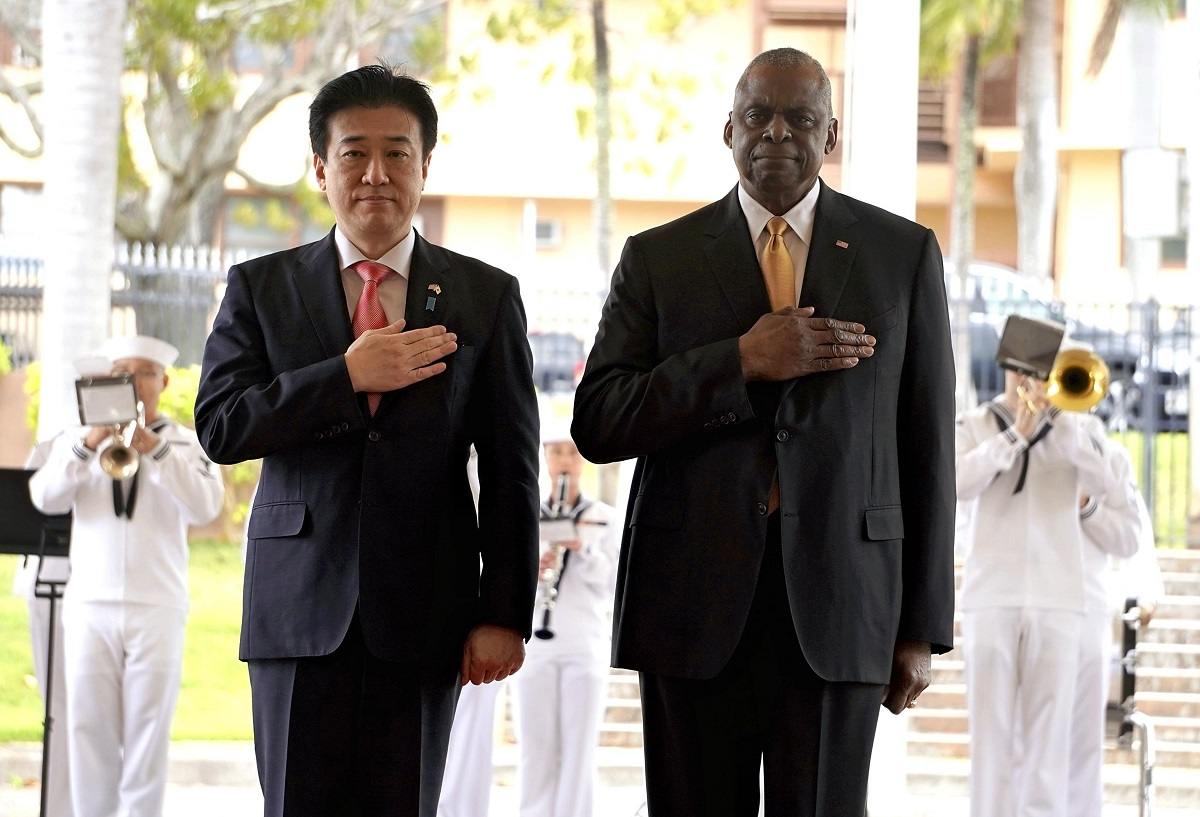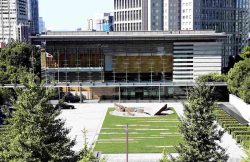Japan, U.S. to Accelerate Efforts for Smoother Command; Aim to Boost SDF, U.S. Forces’ Communication, Info Sharing

Defense Minister Minoru Kihara and U.S. Secretary of Defense Lloyd Austin at a welcoming ceremony for the Japan-U.S. defense ministerial talks at the Indo-Pacific Command in Hawaii on Thursday.
17:59 JST, May 5, 2024
Japan and the United States agreed to accelerate their review of the command and control framework for Japan’s Self-Defense Forces and the U.S. armed forces based in Japan, at the two nations’ defense ministerial talks in Hawaii.
Amid speculation about a Taiwan contingency in which China invades Taiwan, the two countries will aim to build a system that enables smoother reciprocal communication and information-sharing.
“Negotiations are expected to speed up at both the ministerial and working levels. We want to continue discussions at all levels,” Japan’s Defense Minister Minoru Kihara said Friday in Honolulu, in answer to reporters’ questions about his meeting with U.S. Secretary of Defense Lloyd Austin on the previous day. Kihara’s remarks indicated his willingness to move forward with discussions on reviewing the chain of command and unit management on both sides.
Prime Minister Fumio Kishida and U.S. President Joe Biden agreed at their summit in April to review the command and control framework for the SDF and the U.S. military based in Japan. The review is being discussed in conjunction with the planned establishment of the Joint Operations Command that will serve as the central command post for the Ground, Maritime and Air Self-Defense Forces. The new SDF operational system is planned to be established by March 2025.
The two countries plan to begin concrete discussions on what form Japan-U.S. cooperation should take at the Japan-U.S. Security Consultative Committee, or Japan-U.S. “2+2,” among foreign and defense ministers from both countries as early as this summer.
No more ‘double role’
Currently, the chief of staff of the Joint Staff, the top SDF officer, also serves as the Japanese counterpart for U.S. forces — working with the chairman of the U.S. Joint Chiefs of Staff on strategic matters and with the commander of the U.S. Indo-Pacific Command on joint operations.
After the Joint Operations Command is established, its commander will take charge of joint operations, making it possible for the chief of staff of the Joint Staff to concentrate on strategic affairs.
The Japanese side is aiming for prompt reciprocal communications and enhanced cooperation in joint operations with the United States with the establishment of the Joint Operations Command. Japan is asking the United States to reorganize the U.S. forces in Japan to make it possible for Japan to coordinate with the U.S. side within the country.
The command authority of the U.S. Forces in Japan, which is located at Yokota Air Base in Tokyo, is currently limited to base management, among other tasks. The commander of the Indo-Pacific Command has the right to control the U.S. Navy’s Seventh Fleet, which is based at U.S. Fleet Activities Yokosuka in Kanagawa Prefecture, and U.S. Marine Corps units in Okinawa Prefecture and elsewhere.
It has been pointed out that the time difference and distance between Tokyo and Hawaii might make smooth communications and cooperation between the commands difficult in the event of emergencies.
“It’s necessary to have a new command that mainly takes charge of defending Japan,” said Koji Yamazaki, a former chief of staff of the Joint Staff. There is also the hope of ensuring U.S. forces’ commitment to Japan in anticipation of a contingency in the Taiwan Strait.
Constitutional restrictions
The United States has agreed to review the defense command structure because cooperation with the SDF and the presence of U.S. forces in Japan are becoming increasingly important on the global stage.
China’s rapid military buildup is tilting the military balance in the western Pacific to China’s advantage. Calling for “integrated deterrence,” which utilizes the capabilities of U.S. allies, Austin is seeking to maintain the United States’ superiority to China.
Cooperation between U.S. forces in Japan – the world’s largest U.S. forces stationed abroad with more than 50,000 personnel – and the SDF, whose capabilities are strengthening, will be the cornerstone of the approach.
In what is known as the “Armitage-Nye Report,” members of a U.S. bipartisan group called in April for the Japan-U.S. alliance to evolve into “a more integrated alliance, including at the command level.”
Some people in Japan expressed concern regarding this proposal, saying that the SDF might be placed under the command of U.S. forces in the event of emergencies. But the U.S. government does not plan to seek to integrate the right to command, as it is aware of constitutional restrictions on the SDF.
“There will be no change to the principle that the SDF and U.S. forces will each follow an independent chain of command,” Kihara said to reporters.
"Politics" POPULAR ARTICLE
-

Japan to Support Central Asian Logistics Route That Bypasses Russia, Plan to Be Part of Upcoming Summit in Tokyo
-

Japan to Tighten Screening of Foreigners’ Residential Status by Providing Information of Nonpayment of Taxes
-

Takaichi Cabinet Approval Holds at 72% as Voters Back Aggressive Fiscal Stimulus, Child Benefits
-

Chinese, Russian Bombers Flew Unusual Path by Heading Toward Tokyo; Move Likely Meant to Intimidate Japan
-

Takaichi Meets Many World Leaders at G20 Debut in Johannesburg; Speaks with Heads of Countries Including Italy, U.K., Germany, India
JN ACCESS RANKING
-

Keidanren Chairman Yoshinobu Tsutsui Visits Kashiwazaki-Kariwa Nuclear Power Plant; Inspects New Emergency Safety System
-

Imports of Rare Earths from China Facing Delays, May Be Caused by Deterioration of Japan-China Relations
-

University of Tokyo Professor Discusses Japanese Economic Security in Interview Ahead of Forum
-

Japan Pulls out of Vietnam Nuclear Project, Complicating Hanoi’s Power Plans
-

Govt Aims to Expand NISA Program Lineup, Abolish Age Restriction





















